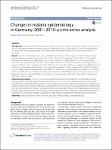Changes in malaria epidemiology in Germany, 2001–2016: a time series analysis
Vygen-Bonnet, Sabine
Stark, Klaus
Background: German surveillance data showed a sharp rise of malaria cases in 2014 and 2015 due to the increased arrival of refugees from malaria endemic countries. A time series analysis of data from 2001 to 2016 was performed in order to describe the epidemiology of imported malaria in Germany in general and of the recent increase in particular. Results: In total, 11,678 malaria cases were notified between 2001 and 2016 (range 526–1063 cases/year). Newly arriving refugees averaged 10 cases/year (1.5%) in 2001–13 and 292.5 cases/year (28.3%) in 2014–15. Plasmodium (P.) falciparum was the most frequently reported species (range 57.2–85.8%), followed by P. vivax (range during 2001–2013: 7.6–18.1%; during 2014–2015, mean 31.3%). In 2014–15, 22.3% of all P. vivax cases were refugees from Eritrea and 3.3% from other countries of the Horn of Africa; in 2015 and 2016, 19.5% were refugees from Afghanistan and Pakistan. Five P. knowlesi malaria infections were reportedly acquired in Thailand between 2012 and 2016. Total numbers of malaria notifications among native Germans and residents with migration background showed an increasing trend since 2007. Chemoprophylaxis use was reported for 24.3% (1695/6984) of cases and showed a declining trend. Native German cases took significantly more frequently chemoprophylaxis than cases with migration background (32.6% vs. 17.9%; p < 0.001). Discussion/conclusions: The steep rise in vivax malaria notifications in 2014 and 2015 was mainly due to newly arriving refugees from Eritrea but also from other countries of the Horn of Africa and South Asia. Clinicians should include malaria in their differential diagnosis in case of a febrile illness in the respective population and consider vivax malaria even if arrival to Germany dates back several months. Over the past 10 years, malaria notifications among native Germans and residents with migration background showed an increasing trend. Use of chemoprophylaxis was insufficient in both groups and deteriorating. New strategies need to be found to increase compliance to chemoprophylaxis recommendations. The surveillance provides valuable data for epidemiological assessment of imported malaria in Germany.
Dateien zu dieser Publikation
Keine Lizenzangabe

